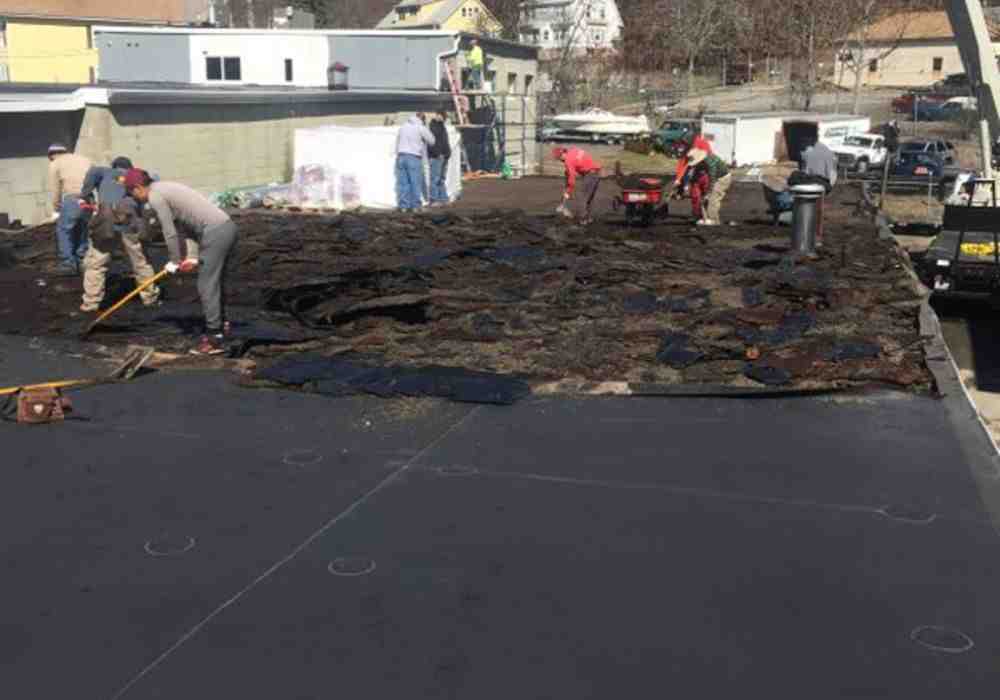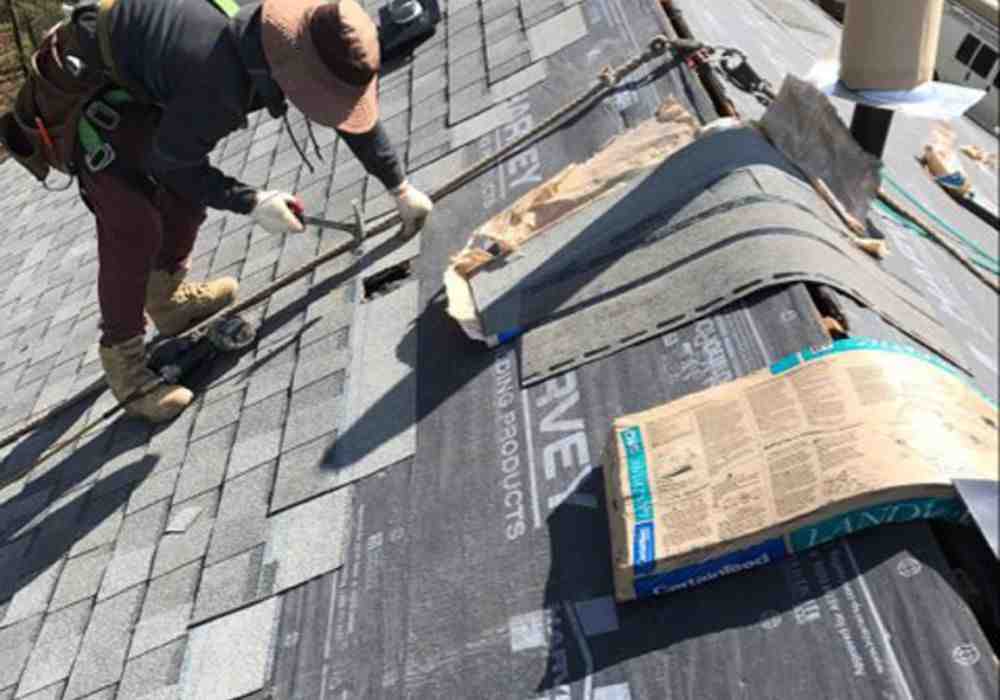Why Roofing Installation is Essential for Your Home
Understanding roofing installation is important for every homeowner. A properly installed roof plays a vital role in protecting your home from weather elements, ensuring energy efficiency, and maintaining structural integrity. Here’s a quick overview to get you started:
- Choosing the Right Materials: Your roof’s longevity and performance depend on selecting suitable materials, such as asphalt, metal, or tile.
- Setting Up the Work Area: Proper preparation, like removing outdoor furniture and securing pets, ensures a smooth installation.
- Removing Old Roofing: This step is essential for a fresh start and involves thoroughly removing old shingles and flashing.
- Inspecting and Repairing: Addressing any structural damage at this stage paves the way for a sturdy roof.
We’ll guide you through the steps, from preparation to the final touch, ensuring that your roofing installation process is clear and hassle-free.
I’m Kevin McLaughlin, owner of Heritage Exteriors LLC, with a lifetime of expertise in roofing installation. My experience ensures your project is in good hands, giving you peace of mind and a roof that stands the test of time.

Pre-Installation Checklist
Before you start your roofing installation project, prepare your home and yard. This preparation ensures a smooth and safe process. Here’s a handy checklist to guide you:
Yard Preparation
Mow the Yard: A clean yard makes it easier to spot any roofing debris that might fall during the project. This step helps in preventing accidents and makes the cleanup process more efficient.
Move Patio Furniture: Relocate any patio furniture away from the house. This prevents damage and provides a clear workspace for your roofing team.
Driveway Photos
Take Pictures: Before any roofing materials or dumpsters are delivered, take photos of your driveway. This helps document any pre-existing conditions and ensures that any potential damage during the project can be addressed properly.
Landscaping Review
Walk Around the House: Inspect your landscaping and flag any delicate areas like landscape lighting. Removing or covering fixtures that aren’t hardwired can prevent accidental damage.
Power Sources
Locate Exterior Power Sources: Identify the outdoor power outlets needed for tools like saws for cutting decking or ridge vents. This ensures your team has easy access to power when needed.
Staging Area
Determine a Staging Area: Decide where materials should be delivered and stored, such as the driveway, side of the house, or garage. This keeps everything organized and out of the way.
Garage Access
Park Cars on the Street: If possible, park your cars on the street while the roofing job is in progress. This keeps them safe from falling debris and provides more space for the roofing team to work.
Ensure Access to Essentials: Make sure you can still access anything you might need in the garage, like cars, bikes, or children’s toys. Plan ahead to avoid any inconvenience.
Ventilation
Check Ventilation: Proper ventilation is crucial to prevent hot air from getting trapped in your home. Make sure your attic has adequate ventilation to maintain a balanced temperature.
Ridge Caps Measurement
Measure Ridge Caps: Measure the length of the ridges and hips on your roof. Divide by 35 to determine how many bundles of ridge shingles you’ll need. This step ensures you have enough materials to complete the job without delays.
By following this pre-installation checklist, you’ll set the stage for a successful and efficient roofing project. Next, we’ll dive into measuring and preparing the roof.
Measuring and Preparing the Roof
Before you start installing your new roof, you need to measure and prepare it properly. This step is crucial because it ensures you have the right amount of materials and helps avoid unnecessary trips to the store.
Measure Roof Width and Length
First, measure the width and length of each section of your roof. Use a tape measure for accuracy. Write down these measurements.
Calculate the Roof Area
Multiply the width and length measurements together to find the area of each section.
For example, if one section is 20 feet wide and 30 feet long:
[ \text{Area} = 20 \, \text{ft} \times 30 \, \text{ft} = 600 \, \text{sq. ft.} ]
Add the areas of all sections together to get the total roof area.
Calculate Squares
Roofing materials are often sold by the “square,” which is 100 square feet. To find out how many squares you need, divide the total roof area by 100.
[ \text{Squares} = \frac{\text{Total Area}}{100} ]
For example, if your total roof area is 2,000 square feet:
[ \text{Squares} = \frac{2000 \, \text{sq. ft.}}{100} = 20 \, \text{squares} ]
Calculate Bundles
Most shingles come in bundles, and it usually takes three bundles to cover one square. Multiply the number of squares by 3 to get the total number of bundles needed.
[ \text{Bundles} = \text{Squares} \times 3 ]
For example, for 20 squares:
[ \text{Bundles} = 20 \, \text{squares} \times 3 = 60 \, \text{bundles} ]
Add Overage and Waste
Always add about 10 to 20 percent extra to account for overage and waste. This ensures you have enough material to cover mistakes and odd cuts.
For example, if you need 60 bundles and add 15% for waste:
[ \text{Extra Bundles} = 60 \, \text{bundles} \times 0.15 = 9 \, \text{bundles} ]
So, you’ll need:
[ 60 \, \text{bundles} + 9 \, \text{extra bundles} = 69 \, \text{bundles} ]
By accurately measuring and preparing your roof, you’ll save time and money. Plus, you’ll avoid the frustration of running out of materials mid-project.
Next, let’s talk about the safety gear you’ll need to keep yourself protected during your roofing installation.
Safety First
When it comes to roofing installation, safety should be your top priority. Working on a roof can be dangerous, and taking the right precautions can prevent accidents. Here’s what you need to know about staying safe:
Safety Gear
Before you start, make sure you have the proper safety gear. This includes:
- Harness: A fall protection kit with a harness, rope, and hook costs about $100. It’s a small price to pay for your safety.
- Hard Hat: Protects your head from falling debris.
- Work Gloves: Keeps your hands safe from sharp objects and rough materials.
- Safety Glasses: Shields your eyes from dust and debris.
- Long Pants: Protects your legs from cuts and abrasions.
- Tool Belt: Keeps your tools handy and reduces the need to climb up and down the ladder.
Partner/Helper
Always have a partner or helper. They can hand you tools, hold the ladder, and call for help if needed. Roofing is not a one-person job.
Setting Up the Ladder
Make sure your ladder can support your weight plus the weight of a bundle of shingles. Extend it at least three feet above the roofline and tie it to the eave to prevent movement. Never step on any rung that extends above the roof.
Using Scaffolding
Set up scaffolding to install the drip edge and the first few courses of shingles safely. This provides a stable platform and reduces the risk of falls.
Proper Footwear
Wear rubber-soled shoes to prevent slipping. Roofing can be slippery, especially if the surface is wet or covered in debris.
Organizing Your Workspace
Keep ropes and extension cords out of your way to avoid tripping. Clean as you go to minimize hazards.
Weather Conditions
Only work in dry, calm weather. Avoid working in windy, wet, or extremely hot conditions. Ideal temperatures are between 50 and 80 degrees Fahrenheit.
By following these safety tips, you can significantly reduce the risk of accidents and injuries during your roofing installation project.
Next, let’s move on to the step-by-step process of tearing off the old roof.
Step-by-Step Roofing Installation Process
Tearing Off the Old Roof
Before you can install new shingles, you need to remove the old ones. This process can be messy, so prepare your workspace with tarps to catch debris.
-
Shingles Removal: Use a roofing fork or shovel to lift old shingles off the roof. Start at the ridge and work your way down.
-
Hammer and Nails: Use a hammer to pry up nails. Be careful not to damage the roof deck.
-
Metal Flashing Removal: Carefully remove any old metal flashing around chimneys, vents, and valleys.
-
Roof Deck Cleaning: Sweep the roof deck clean to remove nails and debris. This ensures a smooth surface for the new shingles.
Installing Deck Protection and Starter Shingles
Once the old roof is off, it’s time to install deck protection and starter shingles.
-
Roof Deck Protection: Lay down shingle underlayment over the roof deck. Use chalk lines to guide your placement and ensure straight rows.
-
Cap Nails: Secure the underlayment with cap nails, overlapping each row by 3-4 inches. This overlap helps prevent water from seeping through.
-
Leak Barrier Protector: In areas prone to inclement weather, consider using a special leak barrier protector.
-
Flashing and Drip Edge: Install new metal flashing, often called a “drip edge,” along the bottom of the roof near the gutters. This helps divert water away from the roof.
-
Starter Shingles: Install starter shingles along the edges. These help prevent water from leaking through the seams of the shingles above.
Installing Roof Shingles
Now, it’s time to install the main shingles.
-
Shingle Courses: Begin laying shingles from the bottom edge, working your way up. Follow the manufacturer’s nailing instructions to ensure proper installation.
-
Nailing Technique: Use 1-1/4-inch zinc-coated roofing nails. Each shingle typically requires five evenly spaced nails.
-
Cut Pattern: Offset each row of shingles by 6 inches to prevent seams from lining up. Use a utility knife to cut shingles as needed.
-
Ridge Shingles: Once you reach the ridge, use the cut-off tabs to create ridge shingles. Fold these over the ridge and nail them in place, overlapping each one.
Adding Flashing and Capping the Ridge
Proper flashing and ridge capping are crucial for preventing leaks.
-
Chimneys and Vents: Install flashing around chimneys, vents, and other roof penetrations. Apply roof sealant along the underside of the flashing for extra protection.
-
Windows and Joints: Use step flashing where the roof meets vertical surfaces like walls or dormers. This directs water away from these joints.
-
Ridge Protection: Cap the ridge with ridge shingles, nailing them in place and applying roofing adhesive to the exposed nail heads for a waterproof seal.
-
Specialty Materials: Use high-quality materials like self-stick underlayment and metal valley flashing for added durability.
By following these steps, you can ensure a solid, leak-proof roofing installation. Next, let’s explore the costs associated with roofing installation.
Cost of Roofing Installation
When it comes to roofing installation, understanding the costs involved is crucial. This section breaks down the expenses you can expect, including material costs, labor costs, and budget considerations.
Material Costs
The type of roofing material you choose greatly impacts the overall cost. Here are some common options:
- Asphalt Shingles: The most popular choice due to their affordability and durability. Prices range from $4.25 to $25 per square foot, including installation.
- Metal Roofing: Known for longevity and energy efficiency. Costs range from $4 to $26 per square foot, depending on the type of metal.
- Tile Roofing: Offers aesthetic appeal and is great for hot climates. Prices generally fall between $7 and $15 per square foot.
- Slate Roofing: A luxury option with a lifespan of over 100 years. Costs can be as high as $30 per square foot.
Labor Costs
Labor is a significant part of the roofing installation cost, often accounting for about 60% of the total expense. Here’s a rough breakdown:
- Basic Installation: $2 to $14 per square foot.
- Complex Roofs: Roofs with steep pitches or many features (chimneys, skylights) can push labor costs to the higher end of the range.
Square Foot Pricing
To estimate the total cost, you’ll need to calculate the area of your roof in square feet. Here’s a simple formula:
- Measure the width and length of each roof section.
- Multiply these measurements to get the area.
- Add the areas of all sections together.
- Divide by 100 to convert to roofing squares (1 square = 100 sq. ft.).
- Multiply by the cost per square foot (material + labor).
For example, a 2,000 sq. ft. roof using asphalt shingles might cost:
- Material: $4.25 to $25 per sq. ft.
- Labor: $2 to $14 per sq. ft.
- Total: $12,500 on average.
Budget Considerations
To stay within budget, consider the following:
- Material Choice: Opt for materials that fit your budget but also meet your durability needs.
- DIY vs. Professional: While DIY can save money, professional installation ensures quality and safety.
- Permits and Inspections: Don’t forget to factor in the cost of necessary permits and inspections, which can add up to $1,000.
By understanding these cost factors, you can make informed decisions and keep your roofing installation project on budget. Next, we’ll address frequently asked questions about the roofing installation process.
Frequently Asked Questions about Roofing Installation
What is the process of installing a roof?
Installing a roof involves several key steps to ensure a sturdy and leak-free result. Here’s a simplified breakdown:
- Tearing Off the Old Roof: Remove old shingles and any damaged decking. Clean the roof deck thoroughly.
- Installing Deck Protection and Starter Shingles: Lay down a protective underlayment and install drip edges and starter shingles.
- Installing Roof Shingles: Begin laying shingles from the bottom edge, working your way up. Ensure proper nailing technique.
- Adding Flashing and Capping the Ridge: Install flashing around chimneys, skylights, and other joints. Finish with ridge shingles for a watertight seal.
This process ensures your roof is well-protected from the elements and durable for years to come.
In what order do you install a roof?
Order of installation is crucial for a successful roofing project. Here’s the sequence:
- Preparation: Clear the area and gather all necessary tools and materials.
- Tear-Off: Remove the old roofing materials down to the roof deck.
- Deck Inspection and Repair: Check for and repair any damage to the roof deck.
- Install Underlayment and Drip Edge: Lay the underlayment and attach the drip edge.
- Starter Shingles: Install the starter strip along the eaves.
- Shingle Installation: Lay shingles in overlapping rows, starting from the bottom.
- Flashing Installation: Add flashing around roof penetrations like chimneys and vents.
- Ridge Cap Shingles: Finish with ridge cap shingles for a clean, finished look.
Following this order helps ensure a seamless and effective installation.
How much does it cost to install shingles on a square roof?
The cost of installing shingles on a square roof can vary based on several factors:
- Material Costs: Asphalt shingles are the most common and affordable, ranging from $100 to $150 per square. Metal or wood shingles can cost significantly more.
- Labor Costs: Professional installation typically costs between $1.50 and $3.00 per square foot.
- Additional Expenses: Factor in costs for permits, inspections, and any necessary repairs to the roof deck.
On average, installing shingles on a 1,000 square foot roof can cost between $4,000 and $6,000. This includes both materials and labor.
By understanding these FAQs, you can better prepare for your roofing installation project. Next, we’ll conclude with how Heritage Exteriors LLC can help you achieve a successful roof installation.
Conclusion
At Heritage Exteriors LLC, we understand that roofing installation is a significant investment in your home. That’s why we’re committed to providing top-quality roofing materials and exceptional customer service to ensure your peace of mind.
High-Quality Roofing Materials
We offer a wide selection of roofing materials to suit your specific needs. Whether you’re interested in the durability of asphalt shingles or the sleek look of metal roofing, our team can help you choose the best option for your home. Our materials are sourced from trusted manufacturers, ensuring longevity and performance.
Exceptional Customer Service
From the initial consultation to the final inspection, our team is dedicated to making your roofing project as smooth as possible. Our project specialists will inspect your home, review material options, and discuss your budget and requirements. We handle everything from pulling necessary permits to hauling away debris once the job is complete.
Peace of Mind
Your peace of mind is our priority. That’s why we offer a two-year labor warranty with every roof installation. This covers labor associated with repairs due to manufacturing or installation defects and includes roof-leak repair. Our team of licensed, insured, and background-checked installers ensures that your project is in capable hands.
Serving Worcester & Middlesex County, MA
We’re proud to serve homeowners in Worcester and Middlesex County, MA. Our local expertise allows us to understand the unique challenges and requirements of roofing in this area. Whether your roof has sustained damage from a storm or is simply due for an upgrade, you can trust Heritage Exteriors LLC to deliver top-notch service.
Ready to start your roofing project? Visit our roofing services page to schedule a consultation and learn more about how we can help you achieve a successful roof installation.


